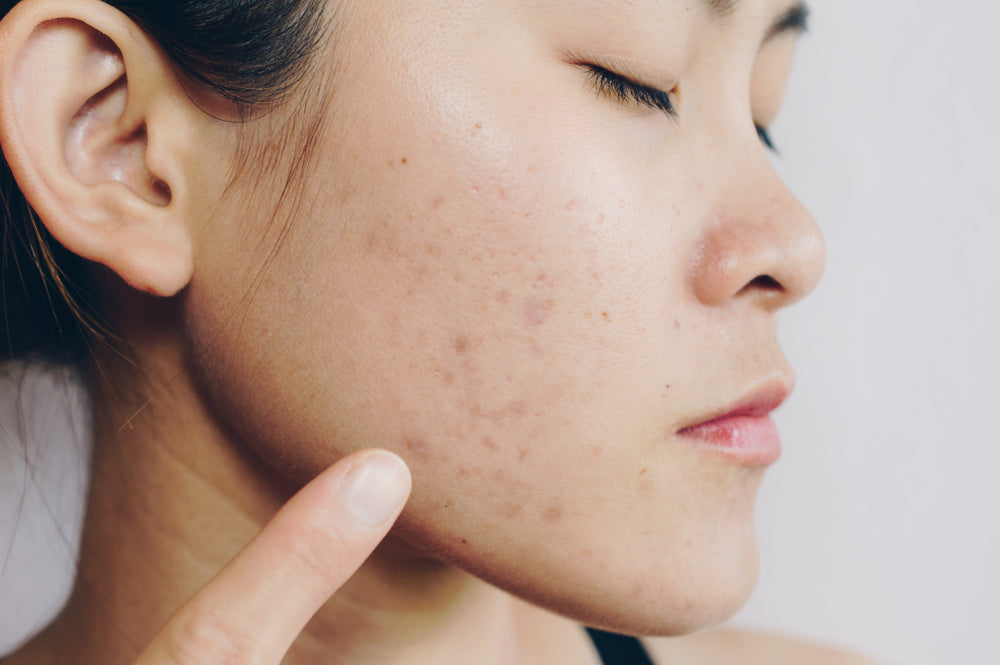If you tackled acne breakouts in the past, it's common for those blemishes to leave their mark on your skin. Before revealing how to get rid of acne scarring and fade hyperpigmentation, it's important to understand the difference between these two marks so that they can be treated correctly.
Generally, marks left from acne are hyperpigmentation. However, if the mark is indented and broken on the skin’s surface it is a scar. “Not all scar-like marks are scars,” Dr. Zenovia says. “Brown and red marks, for example, are hyperpigmentation and will fade with time.”
How to Fade Hyperpigmentation
To fade red marks left on the skin post-acne, you want to focus on decreasing the inflammation. “Sunscreen is imperative because that redness is inflammation and when the sun hits the inflammation it creates and worsens hyperpigmentation,” Dr. Zenovia shares. “The red marks need to be covered from the sun”. Dr. Zenovia’s Vitamin C Brightening Moisturizer SPF 30 is a mineral sunscreen that provides transparent nano zinc-oxide protection from harmful UVA/UVB rays, free radical damage, and environmental stressors. Formulated with clinical-grade Vitamin C-Ester this moisturizing sunscreen visibly helps minimize the appearance of dark spots, discoloration, fine lines, and wrinkles.
To help fade those red marks at night, Dr. Zenovia recommends incorporating her top-selling Inflam-Aging Night Repair Treatment into your skincare regimen. “It’s like putting a baby aspirin on your skin,” Dr. Zenovia shares. “It's a powerful overnight antioxidant serum! This product is part of my Essentials Collection because it’s essential for everyone but is especially great for acne-prone skin. It is a superb product for redness and inflammation”. The skin works to repair itself overnight. Applying a rich layer of the Inflam-Aging Treatment onto a clean face and neck each night will help combat skin aging, brighten the complexion, and improve skin elasticity.
Brown spots signify older pigment. To fade this type of hyperpigmentation, Dr. Zenovia recommends incorporating Vitamin C and sunscreen into your morning skincare regimen and using Glycolic Acid and Retinol several nights each week. Aside from other-the-counter treatments, a board-certified dermatologist can prescribe a bleaching cream with hydroquinone. “It’s important to note that this is a medicine, not just a cream,” says Dr. Zenovia. “If you incorporate hydroquinone into your routine and use it alongside a Retinol and Vitamin C, you will see your brown spots lighten over time.”
In-Office Hyperpigmentation Treatments
Recommended in-office skin treatments for hyperpigmentation include laser therapy and chemical peels. The type of laser or peel to use really depends on your skin type, skin tone, and level of hyperpigmentation. If you have a very light skin tone, certain lasers can actually cause more hyperpigmentation so it’s important to consult with a reputable board-certified dermatologist. Chemical peels are great at sloughing down the top layer of skin, revealing a new layer of skin cells.
How to Fade Acne Scars
True acne scarring appears as indentations on the skin. It is common for acne patients to scar on the sides of the forehead (by the eyes) because there are a lot of sebaceous glands along this area. To help fade acne scars, it is important to use a Vitamin C and sunscreen every morning. Dr. Zenovia’s Vitamin C Brightening Toner is an antioxidant-rich toner that hydrates, replenishes, and conditions the skin while helping to improve the appearance of an uneven tone and texture. At night, using Glycolic Acid and Retinol a few times a week can help improve the appearance of scarring over time. For a nighttime moisturizer, Dr. Zenovia recommends her Aloe Vera Blemish Soothing Moisturizer which is formulated for acne-prone skin experiencing redness.
In-Office Acne Scarring Treatments
Microneedling is a great in-office treatment for true scarring. However, you would need to do microneedling 4-5 times before really seeing an improvement. Dr. Zenovia recommends coupling microneedling with radiofrequency, a new kind of laser in the skin treatment space. Microneedling helps get into the scar and radiofrequency helps heat the base of those needles, stretching out the scarring.
C02 laser resurfacing can also help take off that top layer of skin. Dr. Zenovia is a fan of using C02 as well as the Genius by Lutronic laser with radiofrequency. A board-certified dermatologist can decide which treatment is best for you after examining your skin. Both of these treatments are superb for acne scarring.
[slider collection="treatments" title="Shop Hormonal Skin Care Treatments"]


